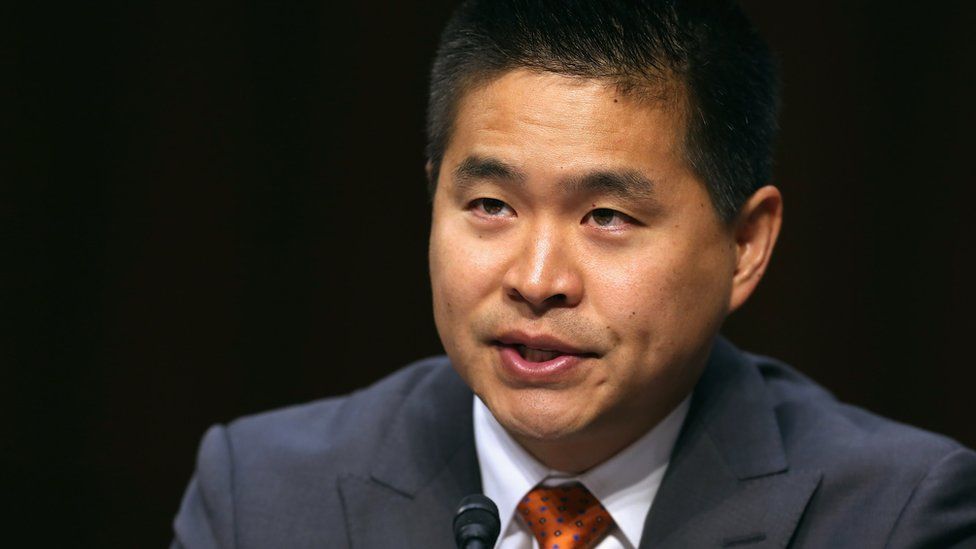How one man took on Wall Street and won
- Published

As David and Goliath stories go, Brad Katsuyama's is a pretty good one.
The 38-year-old has taken on billions of dollars of vested interest on Wall Street, and won for the little guy.
His successes were detailed in the best-selling book Flash Boys by Michael Lewis, and apt for a tale that could read like a Hollywood movie script, Sony Pictures bought the film rights.
Brad's story started in 2002 when he began working as a stockbroker in New York for the Royal Bank of Canada, aged 24.
Buying shares for his clients, Brad kept running into the same problem.
It went something like this - his team would go to purchase a bundle of stocks at a certain price. But once they pressed "buy", only part of the order was available, and the price for the rest had gone up.
After some investigation he found that the problem was caused by something called "high frequency trading" (HFT).
But what is HFT? And why should we care?
HFT is a system that uses complex computer programs to execute millions of trades per second.
Using information generated at speeds many times faster than the blink of an eye, super-fast computers installed with HFT software can estimate the rising value of a stock before the increase takes place.
Utilising HFT since 1999 has enabled some large investment banks, hedge funds, and other institutional investors to buy stocks microseconds before everyone else. They then make a profit - billions of dollars over the years - by selling the shares on at a higher price.
Brad, who was trading for the likes of pension funds, and didn't have access to HFT, thought it was completely unfair. And he was determined to do something to prevent it.
So with a team of colleagues Brad started work on a way to disable HFT.
Leaving Royal Bank of Canada with its blessing, in 2012 Brad established a stock brokerage called IEX that would utilise a method to remove the advantage of HFT.
What they devised was a "speed bump", a system whereby trades are slowed down by 350 microseconds by using 38 miles of fibre optic cable stored in a compartment the size of a shoe box.
This doesn't sound like much of a time lapse - but it was enough of a delay to even the playing field by stalling HFT.
So anyone buying shares via IEX would not be at risk of an HFT rushing ahead of them. And IEX - like any other stock brokerage - would make its money by taking a small commission.
But while Brad and his colleagues thought they had come up with a great idea, not many people were initially interested.
Starting out in a 200 sq ft (18.5 sq m) windowless office space in downtown Manhattan, the company could barely afford to pay salaries, and struggled to attract start-up funding.
"I think the idea sounded a bit crazier [to other people] than we first thought," Brad admits.
But Brad's competitive nature - honed over years of playing hockey and the Canadian version of American football, wouldn't let him quit.
And IEX eventually began to make headway among traders looking to escape a market that seemed rigged against them.
But the biggest boost for IEX was the March 2014 release of the book Flash Boys by financial journalist Michael Lewis.
Brad says it changed his life but more importantly, it helped the public understand the issue.
Before Flash Boys was released the company struggled to attract new talent. "We had to find people who really believed in what we were doing," he says.
But after Flash Boys became a best-seller, IEX started to receive hundreds of application letters, and it was able to raise $75m (£53m) from investors.
Yet the company's higher profile, and then Brad's application for it to become a bona fide stock market, sparked a furious response from many in the Wall Street establishment who defended HFT and attacked IEX.
IEX's opponents said its speed bump was unfair and wrong because it distorted prices.
Jeff Sprecher, the chief executive of Intercontinental Exchange, the company that owns the New York Stock Exchange, even went as far as calling IEX's approach "un-American".
Bill Hart, boss of Modern Markets Initiative, a group that advocates HFT, says: "Investors should always know the right price for their stock, by slowing that down we think investors won't see the best price."
Yet despite all the criticism of IEX, earlier this month the US regulator, the Securities and Exchange Commission, approved it becoming the 13th stock exchange in the US.
IEX, which is profitable but currently handles only 1.6% of US stock trades, expects business to now grow extensively.
One of the numerous benefits of becoming an official stock exchange is that traders are legally bound to send orders to it if the stock prices listed there are better than other markets.
"Brad and his team have done a great job," says share trader Joseph Saluzzi of Themis Trading, and co-author of a book on HFT.
"They have taken some hits from major players who threw everything at them to stop them, and had the money and lobbyists to do it, and after all that IEX hasn't changed its general philosophy."
Now with a team of 70 people, IEX has upgraded its office to the 44th floor of 4 World Trade Center, one of the new skyscrapers built on the site of the former World Trade Center at the southern tip of Manhattan.
Brad's David has certainly beaten Goliath so far.